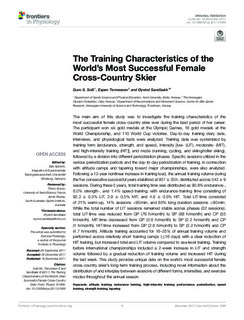| dc.description.abstract | The main aim of this study was to investigate the training characteristics of the most successful female cross-country skier ever during the best period of her career. The participant won six gold medals at the Olympic Games, 18 gold medals at the World Championship, and 110 World Cup victories. Day-to-day training diary data, interviews, and physiological tests were analyzed. Training data was systemized by training form (endurance, strength, and speed), intensity [low- (LIT), moderate- (MIT), and high-intensity training (HIT)], and mode (running, cycling, and skiing/roller skiing), followed by a division into different periodization phases. Specific sessions utilized in the various periodization periods and the day-to-day periodization of training, in connection with altitude camps and tapering toward major championships, were also analyzed. Following a 12-year nonlinear increase in training load, the annual training volume during the five consecutive successful years stabilized at 937 ± 25 h, distributed across 543 ± 9 sessions. During these 5 years, total training time was distributed as 90.6% endurance-, 8.0% strength-, and 1.4% speed-training, with endurance-training time consisting of 92.3 ± 0.3% LIT, 2.9 ± 0.5% MIT, and 4.8 ± 0.5% HIT. Total LIT-time consisted of 21% warm-up, 14% sessions <90 min, and 65% long-duration sessions >90 min. While the total number of LIT sessions remained stable across phases (32 sessions), total LIT-time was reduced from GP (76 h/month) to SP (68 h/month) and CP (55 h/month). MIT-time decreased from GP (2.8 h/month) to SP (2.2 h/month) and CP (1 h/month). HIT-time increased from GP (2.8 h/month) to SP (3.2 h/month) and CP (4.7 h/month). Altitude training accounted for 18–25% of annual training volume and performed across relatively short training camps (≤16 days) with a clear reduction of HIT training, but increased total and LIT volume compared to sea-level training. Training before international championships included a 2-week increase in LIT and strength volume followed by a gradual reduction of training volume and increased HIT during the last week. This study provides unique data on the world's most successful female cross-country skier's long-term training process, including novel information about the distribution of and interplay between sessions of different forms, intensities, and exercise modes throughout the annual season. | nb_NO |

